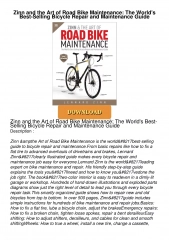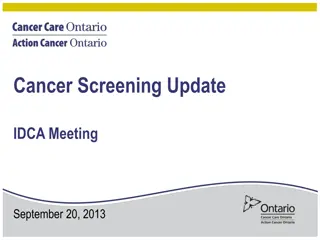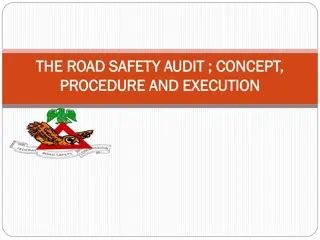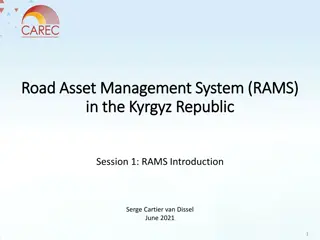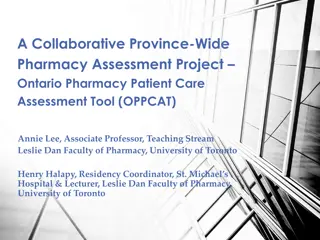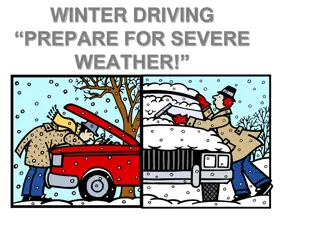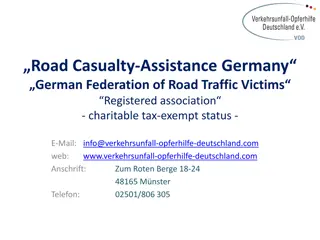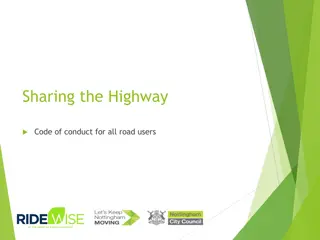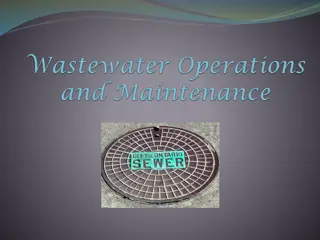Winter Minimum Maintenance Standards & Road Classification in Ontario
The City of Timmins updates its Winter Minimum Maintenance Standards in January 2021. Municipalities in Ontario are responsible for maintaining highways as per the Municipal Act 2001. The act, along with Ontario Regulation 239/02, outlines the Minimum Maintenance Standards for Municipal Highways. Ontario roads are classified based on Average Daily Traffic and Posted Speed Limits. This classification includes various speed limits and traffic volume ranges. Connecting link classifications such as King, Harold, Hwy 101, Algonquin, and Riverside Drive are also detailed.
Download Presentation

Please find below an Image/Link to download the presentation.
The content on the website is provided AS IS for your information and personal use only. It may not be sold, licensed, or shared on other websites without obtaining consent from the author. Download presentation by click this link. If you encounter any issues during the download, it is possible that the publisher has removed the file from their server.
E N D
Presentation Transcript
Winter Minimum Maintenance Standards City of Timmins Update January , 2021
Municipal Act 2001 Municipalities in Ontario are responsible for the maintenance of highways as prescribed in the Municipal Act 2001 Ontario Regulation 239/02 - Minimum Maintenance Standards for Municipal Highways provides the details with regards to the standards to be achieved. The latest revisions were made May 3, 2018
Road Classification Ontario roads are classified on the basis of Average Daily Traffic and Posted Speed Limits Column 6 51 - 60 km/h speed limit Column 3 81 - 90 km/h speed limit Column 4 71 - 80 km/h speed limit Column 5 61 - 70 km/h speed limit Column 7 41 - 50 km/h speed limit Column 1 Column 2 91 - 100 km/h speed limit Column 8 1 - 40 km/h speed limit Average Daily Traffic (number of motor vehicles) 53,000 or more 23,000 - 52,999 15,000 - 22,999 12,000 - 14,999 10,000 - 11,999 8,000 - 9,999 6,000 - 7,999 5,000 - 5,999 4,000 - 4,999 3,000 - 3,999 2,000 - 2,999 1,000 - 1,999 500 - 999 200 - 499 50 - 199 0 - 49 1 1 1 1 1 1 1 1 1 1 1 1 1 1 1 1 1 1 1 1 1 1 2 2 2 2 2 3 3 3 3 3 1 1 2 2 2 2 2 2 3 3 3 3 4 4 4 6 1 2 2 2 2 3 3 3 3 3 3 3 4 4 5 6 1 2 2 2 3 3 3 3 3 3 4 4 4 5 5 6 1 2 3 3 3 3 4 4 4 4 5 5 5 5 6 6 1 2 3 3 3 3 4 4 4 4 5 5 5 6 6 6
Connecting Link Classification King, Harold, Hwy 101, Algonquin and Riverside Drive Column 6 51 - 60 km/h speed limit Column 3 81 - 90 km/h speed limit Column 4 71 - 80 km/h speed limit Column 5 61 - 70 km/h speed limit Column 7 41 - 50 km/h speed limit Column 1 Column 2 91 - 100 km/h speed limit Column 8 1 - 40 km/h speed limit Average Daily Traffic (number of motor vehicles) 53,000 or more 23,000 - 52,999 15,000 - 22,999 12,000 - 14,999 10,000 - 11,999 8,000 - 9,999 6,000 - 7,999 5,000 - 5,999 4,000 - 4,999 3,000 - 3,999 2,000 - 2,999 1,000 - 1,999 500 - 999 200 - 499 50 - 199 0 - 49 1 1 1 1 1 1 1 1 1 1 1 1 1 1 1 1 1 1 1 1 1 1 2 2 2 2 2 3 3 3 3 3 1 1 2 2 2 2 2 2 3 3 3 3 4 4 4 6 1 2 2 2 2 3 3 3 3 3 3 3 4 4 5 6 1 2 2 2 3 3 3 3 3 3 4 4 4 5 5 6 1 2 3 3 3 3 4 4 4 4 5 5 5 5 6 6 1 2 3 3 3 3 4 4 4 4 5 5 5 6 6 6
Collector Roads Classification Ross/Jubilee, Theriault, Airport Road, Laforest & Shirley, Pine, Maclean, Park, Brunette Column 6 51 - 60 km/h speed limit Column 3 81 - 90 km/h speed limit Column 4 71 - 80 km/h speed limit Column 5 61 - 70 km/h speed limit Column 7 41 - 50 km/h speed limit Column 1 Column 2 91 - 100 km/h speed limit Column 8 1 - 40 km/h speed limit Average Daily Traffic (number of motor vehicles) 53,000 or more 23,000 - 52,999 15,000 - 22,999 12,000 - 14,999 10,000 - 11,999 8,000 - 9,999 6,000 - 7,999 5,000 - 5,999 4,000 - 4,999 3,000 - 3,999 2,000 - 2,999 1,000 - 1,999 500 - 999 200 - 499 50 - 199 0 - 49 1 1 1 1 1 1 1 1 1 1 1 1 1 1 1 1 1 1 1 1 1 1 2 2 2 2 2 3 3 3 3 3 1 1 2 2 2 2 2 2 3 3 3 3 4 4 4 6 1 2 2 2 2 3 3 3 3 3 3 3 4 4 5 6 1 2 2 2 3 3 3 3 3 3 4 4 4 5 5 6 1 2 3 3 3 3 4 4 4 4 5 5 5 5 6 6 1 2 3 3 3 3 4 4 4 4 5 5 5 6 6 6
Arterials & Rural Roads Classification Kamiskotia, Municipal, Frederick House Lake Rd., Finn Rd., Sandy Falls, Kraft Creek, Carrigan, Mahoney, Gibson Lake, etc. Column 6 51 - 60 km/h speed limit Column 3 81 - 90 km/h speed limit Column 4 71 - 80 km/h speed limit Column 5 61 - 70 km/h speed limit Column 7 41 - 50 km/h speed limit Column 1 Column 2 91 - 100 km/h speed limit Column 8 1 - 40 km/h speed limit Average Daily Traffic (number of motor vehicles) 53,000 or more 23,000 - 52,999 15,000 - 22,999 12,000 - 14,999 10,000 - 11,999 8,000 - 9,999 6,000 - 7,999 5,000 - 5,999 4,000 - 4,999 3,000 - 3,999 2,000 - 2,999 1,000 - 1,999 500 - 999 200 - 499 50 - 199 0 - 49 1 1 1 1 1 1 1 1 1 1 1 1 1 1 1 1 1 1 1 1 1 1 2 2 2 2 2 3 3 3 3 3 1 1 2 2 2 2 2 2 3 3 3 3 4 4 4 6 1 2 2 2 2 3 3 3 3 3 3 3 4 4 5 6 1 2 2 2 3 3 3 3 3 3 4 4 4 5 5 6 1 2 3 3 3 3 4 4 4 4 5 5 5 5 6 6 1 2 3 3 3 3 4 4 4 4 5 5 5 6 6 6
Residential Street Classification Most streets 2 lane residential streets in all 5 wards are classified as 5 or 6 Column 6 51 - 60 km/h speed limit Column 3 81 - 90 km/h speed limit Column 4 71 - 80 km/h speed limit Column 5 61 - 70 km/h speed limit Column 7 41 - 50 km/h speed limit Column 1 Column 2 91 - 100 km/h speed limit Column 8 1 - 40 km/h speed limit Average Daily Traffic (number of motor vehicles) 53,000 or more 23,000 - 52,999 15,000 - 22,999 12,000 - 14,999 10,000 - 11,999 8,000 - 9,999 6,000 - 7,999 5,000 - 5,999 4,000 - 4,999 3,000 - 3,999 2,000 - 2,999 1,000 - 1,999 500 - 999 200 - 499 50 - 199 0 - 49 1 1 1 1 1 1 1 1 1 1 1 1 1 1 1 1 1 1 1 1 1 1 2 2 2 2 2 3 3 3 3 3 1 1 2 2 2 2 2 2 3 3 3 3 4 4 4 6 1 2 2 2 2 3 3 3 3 3 3 3 4 4 5 6 1 2 2 2 3 3 3 3 3 3 4 4 4 5 5 6 1 2 3 3 3 3 4 4 4 4 5 5 5 5 6 6 1 2 3 3 3 3 4 4 4 4 5 5 5 6 6 6
What is the road class for the connecting link? Connecting link - generally operates as a Class 2 highway. City of Timmins deploys resources on the connecting link in accordance to a Class 2 highway standards. In addition, Theriault, Airport Road, Lafleur Drive, Shirley and Ross/ Jubilee get the same level of service. A 5cm snow accumulation is required to initiate a plowing activity. We generally deploy within 1 hour.
What is the road class for the collector roads? Collectors generally operate as a Class 3 or 4 highway. City of Timmins deploys resources on high speed collectors in accordance to a Class 3 highway standards. An 8cm snow accumulation is required to initiate a plowing activity and we have 12 hours to deploy once we have been made aware. We generally deploy within 6 hours and it very much depends on the storm intensity and weather forecast.
What is the road class for the rural roads & residential streets ? Most rural roads and residential streets generally operate as a Class 4 , 5 and some 6 highways. City of Timmins deploys resources on the these roads in accordance to a Class 4 & 5 highway standards. An 8 to 10 cm snow accumulation is required to initiate a plowing activity and we have 12 to 24 hours to deploy once we have been made aware. We generally schedule a city wide plowing operations to start at midnight, and will supplement depending on the storm intensity and weather forecast.
What does the MMS say about snow accumulation? DURING A SNOW STORM, the MMS says that once the municipality is aware that snow accumulation is greater than that set in the Table, the municipality is required to deploy resources as soon as practicable to address the snow accumulation. Effective May 3, 2018 The Municipality can declare a Significant Weather Event, such as a blizzard, heavy snowfall warning or freezing rain event.
What is a Significant Weather Event? significant weather event means an approaching or occurring weather hazard with the potential to pose a significant danger to users of the highways within a municipality;. What does the MMS say about significant weather events? If a municipality declares a significant weather event relating to snow accumulation, the standards set out by the MMS for Snow accumulation on roadways, sidewalks and bicycle lanes as well as icy roads, roadways sidewalks and bicycle lanes is suspended. The roads, sidewalks and bicycle lanes are deemed to be in a state of repair until the end of the significant weather event as long as the municipality does the following: Monitor the weather If deemed practicable by the municipality, to deploy resources to address the condition, starting from the time that the municipality deems appropriate to do so. Time lines laid out in the MMS start back up at the end of the declaration of the end of the Significant Weather Event, and the municipality shall declare the end of the significant weather event when the municipality determines it is appropriate to do so.
What does the MMS say about snow accumulation? WHEN A STORM HAS ENDED, the MMS says that the municipality is responsible to reduce the snow to a depth less or equal to the depth set out in the Table within the time set out in the Table and to provide a minimum lane width. Class Depth Time 1 2.5cm 4 hours 2 5.0cm 6 hours 3 8.0cm 12 hours 4 8.0cm 5 10.0cm 24 hours Lane width of 3.0 meters or the actual lane width which ever is less for each lane. Class 4 & 5 must be a minimum 5 meters for 2 lanes. 16 hours
What does the MMS say about snow accumulation? Important clause to recognize and understand ONT REG 239/02 Section 4 subsection 2 If the depth of snow accumulation on a roadway is less or equal to the depth set out in the Table, the roadway is deemed to be in a state of repair with respect to snow accumulation. i.e. a Class 5 road with 10 cm of snow accumulation on it is deemed to be in a state of repair and does not require immediate attention.
The level of service provided by the City of Timmins Once a storm has ended, the City of Timmins can plow all of the roads under its jurisdiction within a period ranging from 12 to 18 hours. This includes rural roads, laneways and some parking lots. Some highways receive a 24 hour bare pavement level of service, which greatly exceeds the classification for such roads. Snow accumulation is completely pushed off the travelled roadway within 12 to 18 hours which exceeds the requirements for all classes. (i.e. zero accumulation on travelled portion of roadways)
What does the MMS say about ice formation and treating icy conditions? The standard for the prevention of ice formation on roadways is doing the following in the 24-hour period preceding an alleged formation of ice on a roadway: 1. 2. 3. Monitor the weather in accordance to section 3.1 Patrol in accordance to section 3 If the municipality determines, as a result of its activities under paragraph 1 or 2, that there is a substantial probability of ice forming on a roadway, treat the roadway, if practicable, to prevent ice formation within the time set out in Table 1 to this section, starting from the time that the municipality determines is the appropriate time to deploy resources for that purpose
What does the MMS say about ice formation and preventing icy conditions? The standard for the prevention of ice formation on roadways if practicable in Table 1 is as follows: Class Time 1 6 hours 2 8 hours 3 16 hours 4 24 hours 5 24 hours The best practice for the prevention of icing is to have DLA (direct liquid application) program. This is identified in the City of Timmins slat Management plan as a future aspiration.
What does the MMS say about ice formation and treating icy conditions? Once ice forms on a roadway Table 2 sets out the minimum response times to treat the icy conditions once the Municipality becomes aware of the fact a roadway is icy Class Time 1 3 hours 2 4 hours 3 8 hours 4 12 hours 5 16 hours
What do we do about icy conditions? Public works subscribes to a commercial weather forecaster who provides us two (2) local area forecasts (LAF) and 3 virtual Road Weather Information System forecasts (RWIS) 3 times a day.
What do we do about icy conditions? We also patrol our class 1,2,3 and select class 4 roads on a 24/7 basis and dispatch our Highway Maintenance Contractor immediately as snow starts to accumulate on the roadways, or as freezing rain starts. All remaining class 4, 5 and 6 roadways are patrolled 7 days a week by sand truck operators and sanded as required, as well as weekly by supervisory staff.


